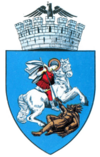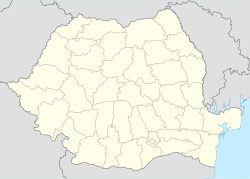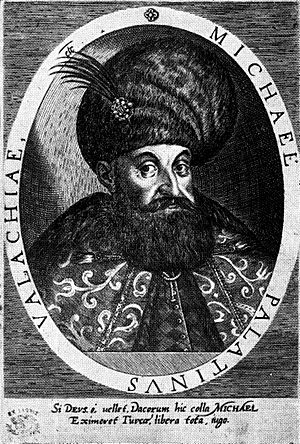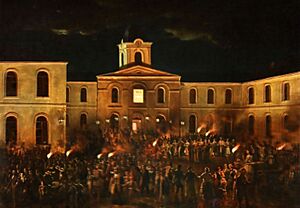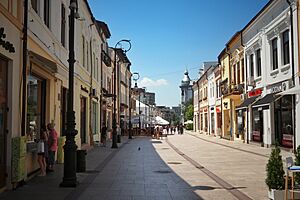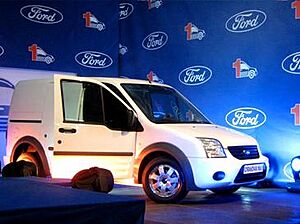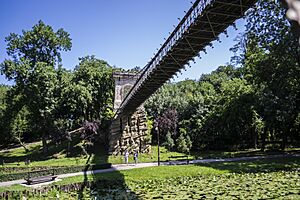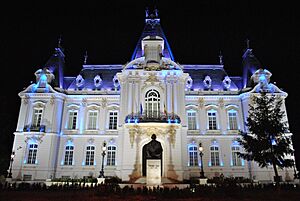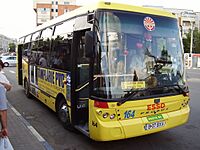Craiova facts for kids
Quick facts for kids
Craiova
|
||
|---|---|---|
     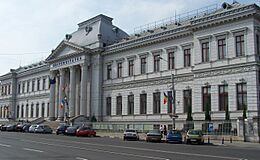
From top, clockwise: Dolj County Prefecture • Bibescu Manor House • Museum of Oltenia • University of Craiova • Carol I National College • Constantin Mihail Palace
|
||
|
||
| Nickname(s):
Bans' Citadel
(Romanian: Cetatea Băniei) |
||
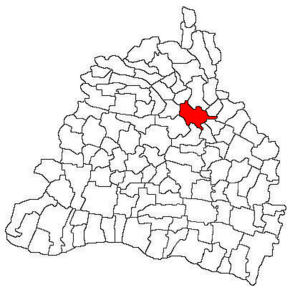
Location in Dolj County
|
||
| Country | ||
| County | Dolj County | |
| Status | County capital | |
| Area | ||
| • City | 81.41 km2 (31.43 sq mi) | |
| • Metro | 1,498.6 km2 (578.6 sq mi) | |
| Elevation | 100 m (300 ft) | |
| Population
(2021 census)
|
||
| • City | 234,140 | |
| • Density | 2,877/km2 (7,450/sq mi) | |
| • Metro | 356,544 | |
| Time zone | UTC+2 (EET) | |
| • Summer (DST) | UTC+3 (EEST) | |
| Postal code |
200xxx
|
|
| Area code(s) | (+40) 251 | |
| Vehicle registration | DJ | |
Craiova is a big city in southwestern Romania. It's the seventh largest city in the country and the main city of Dolj County. You can find it near the Jiu River in a region called Oltenia.
Craiova has been an important center for a long time. It's located almost exactly halfway between the Southern Carpathians mountains to the north and the Danube River to the south. It's the most important city in Oltenia and a major trading hub west of Bucharest. The city has faced challenges like an earthquake in 1790 and a plague in 1795, but it always managed to grow and prosper.
The city of Craiova also includes eight smaller villages: Făcăi, Mofleni, Popoveni, Șimnicu de Jos, Cernele, Cernelele de Sus, Izvoru Rece, and Rovine. Some of these villages used to be a separate town until 1996, when they became part of Craiova.
Contents
What's in a Name?
The name Craiova might come from two old words. One idea is that it comes from the Old Slavonic word kral, meaning "king." This word became crai in Romanian. The other idea is that it comes from the Slavonic word krajina, which means "border" or "edge."
Since no one wrote about the city before 1475, it's hard to know for sure which word is the real origin. The name might have come from Serbian people who lived in the area a long time ago.
In Hungarian, the city is called Királyi (meaning "royal") or Krajova. In German, it's called Krajowa.
A Look Back in Time
![]() Wallachia 1475–1718
Wallachia 1475–1718
![]() Habsburg Monarchy 1718–1739
Habsburg Monarchy 1718–1739
![]() Wallachia 1739–1859
Wallachia 1739–1859
![]() United Principalities of Moldavia and Wallachia 1859–1862
United Principalities of Moldavia and Wallachia 1859–1862
![]() Romanian United Principalities 1862–1866
Romanian United Principalities 1862–1866
![]() Romania 1866–present
Romania 1866–present
Craiova is built on the site of an old city called Pelendava, which was first a Dacian city and later a Roman one. Craiova used to be the capital of Oltenia. Its ancient leaders were called bans. These bans were the most important noblemen, called boyars, in the state of Wallachia. They even had the right to make their own coins! This is where the Romanian word ban, used for money, comes from.
The Craiovești family was very powerful in the late 1500s. They owned about 100 villages. This made them so strong that the rulers of Wallachia at the time needed their help to stay in power. Many rulers of the country came from the Craiovești family, including Neagoe Basarab and Constantin Brâncoveanu.
In 1395, Craiova might have been where Mircea I of Wallachia, a Wallachian prince, won a battle against Bayezid I, the Sultan of the Ottoman Empire. This was part of the Battle of Rovine.
Craiova has always been an important economic area for Wallachia and Romania. Between 1718 and 1739, when the Habsburgs ruled Oltenia, Craiova's importance decreased. This was because of economic problems and more control from the central government.
In 1761, the bans moved to Bucharest, leaving people called kaymakams to represent them in Craiova. Later, from 1770 to 1771, Craiova became the capital of Wallachia for a short time during a war. In 1800, a large part of the city was burned down by a rebel leader named Osman Pazvantoğlu.
During the Wallachian uprising of 1821, many people from the Craiova area joined Tudor Vladimirescu's fighters, called Vladimirescu's Pandurs, to march on Bucharest. In the early 1800s, Craiova became very successful in trade and services. By 1832, it had 595 shops. Craiova exported goods like wheat, furs, leather, and animals to the Austrian and Ottoman Empires.
Costache Romanescu, a citizen of Craiova, was one of the leaders of the government during the 1848 Wallachian revolution. The last two rulers of Wallachia, Gheorghe Bibescu and Barbu Dimitrie Știrbei, came from a powerful family in Craiova, the Bibescu family.
Around 1860, Craiova had 4,633 buildings, including 3,220 houses, 26 churches, 11 schools, and 60 factories. About 90 industrial businesses were in the city, like mills, breweries, and printing presses. More than half of all the skilled workers in Dolj County lived in Craiova.
After the Independence War, Craiova grew even more. By the end of the 1800s, it had small factories making chemicals, farm tools, and building materials. On October 26, 1896, Craiova became the first city in Romania to have electric power from engines, lighting up 39 streets with 365 streetlights.
In 1900, Craiova had 43.1% of all the factories in Oltenia. There were 924 industrial companies, including 20 large ones. The number of large factories grew to 40 by 1925. Banking also became important, with 6 banks and 2 money exchange offices.
Between World War I and World War II, Craiova didn't industrialize as fast as other Romanian cities because it was mainly an agricultural area. In 1939, only 7 factories in Craiova had more than 100 workers. However, its printing houses were famous across Romania and even abroad. The Treaty of Craiova was signed here on September 7, 1940. This treaty meant Romania gave Southern Dobruja to Bulgaria.
In the early 1960s, under the Communist government, Craiova became a major center for making cars, engines, airplanes, chemicals, and food. Many new apartment buildings were also built during this time.
After the 1989 Revolution, Romania changed to a free market economy. Many industries became private. Even though the economy changed a lot, industry is still very important to Craiova, making up about 70% of what the city produces.
Where is Craiova?
Weather in Craiova
Craiova has a climate that brings both cold winters and long, hot summers. It's not usually cold enough for snow to stay on the ground all winter.
Every year, Craiova has about 64 foggy days, mostly in winter. It also has about 34 days with thunderstorms and 1 day with hail.
| Climate data for Craiova (1991–2020, extremes since 1931) | |||||||||||||
|---|---|---|---|---|---|---|---|---|---|---|---|---|---|
| Month | Jan | Feb | Mar | Apr | May | Jun | Jul | Aug | Sep | Oct | Nov | Dec | Year |
| Record high °C (°F) | 16.8 (62.2) |
21.4 (70.5) |
28.4 (83.1) |
31.8 (89.2) |
35.3 (95.5) |
38.8 (101.8) |
40.4 (104.7) |
40.8 (105.4) |
40.1 (104.2) |
34.4 (93.9) |
23.5 (74.3) |
18.4 (65.1) |
40.8 (105.4) |
| Mean daily maximum °C (°F) | 3.0 (37.4) |
6.2 (43.2) |
12.1 (53.8) |
18.2 (64.8) |
23.6 (74.5) |
27.8 (82.0) |
30.2 (86.4) |
30.3 (86.5) |
24.7 (76.5) |
17.6 (63.7) |
9.9 (49.8) |
3.9 (39.0) |
17.3 (63.1) |
| Daily mean °C (°F) | −0.9 (30.4) |
1.3 (34.3) |
6.2 (43.2) |
12.0 (53.6) |
17.2 (63.0) |
21.3 (70.3) |
23.3 (73.9) |
23.1 (73.6) |
17.8 (64.0) |
11.7 (53.1) |
5.8 (42.4) |
0.3 (32.5) |
11.6 (52.9) |
| Mean daily minimum °C (°F) | −4.1 (24.6) |
−2.3 (27.9) |
1.7 (35.1) |
6.7 (44.1) |
11.4 (52.5) |
15.1 (59.2) |
16.9 (62.4) |
16.9 (62.4) |
12.4 (54.3) |
7.4 (45.3) |
2.6 (36.7) |
−2.5 (27.5) |
6.9 (44.3) |
| Record low °C (°F) | −30.5 (−22.9) |
−27.4 (−17.3) |
−19.4 (−2.9) |
−4.4 (24.1) |
−2.0 (28.4) |
4.4 (39.9) |
7.5 (45.5) |
6.4 (43.5) |
−2.0 (28.4) |
−6.0 (21.2) |
−14.8 (5.4) |
−24.1 (−11.4) |
−30.5 (−22.9) |
| Average precipitation mm (inches) | 42.5 (1.67) |
33.9 (1.33) |
45.9 (1.81) |
48.8 (1.92) |
67.6 (2.66) |
74.5 (2.93) |
73.3 (2.89) |
47.5 (1.87) |
52.5 (2.07) |
51.9 (2.04) |
48.4 (1.91) |
50.2 (1.98) |
637 (25.08) |
| Average snowfall cm (inches) | 13.7 (5.4) |
11.7 (4.6) |
6.6 (2.6) |
2.5 (1.0) |
0.0 (0.0) |
0.0 (0.0) |
0.0 (0.0) |
0.0 (0.0) |
0.0 (0.0) |
2.5 (1.0) |
7.9 (3.1) |
10.2 (4.0) |
55.1 (21.7) |
| Average precipitation days (≥ 1.0 mm) | 6.6 | 5.6 | 6.5 | 6.8 | 9.1 | 7.1 | 6.3 | 4.8 | 5.5 | 6.1 | 6.2 | 6.9 | 77.5 |
| Average relative humidity (%) | 89 | 87 | 81 | 75 | 75 | 75 | 73 | 72 | 73 | 80 | 88 | 91 | 80 |
| Average dew point °C (°F) | −3.7 (25.3) |
−2.3 (27.9) |
1.6 (34.9) |
6.1 (43.0) |
11.1 (52.0) |
14.3 (57.7) |
15.6 (60.1) |
15.1 (59.2) |
12.0 (53.6) |
7.3 (45.1) |
2.8 (37.0) |
−1.0 (30.2) |
6.6 (43.8) |
| Mean monthly sunshine hours | 94 | 125 | 177 | 210 | 254 | 276 | 299 | 291 | 219 | 159 | 89 | 75 | 2,268 |
| Source 1: NOAA | |||||||||||||
| Source 2: Deutscher Wetterdienst (extremes and humidity, 1973–1992) | |||||||||||||
People in Craiova
| Historical population of Craiova | |||||||||||||
| Year | Population | %± | |||||||||||
|---|---|---|---|---|---|---|---|---|---|---|---|---|---|
| 1859 | 21,521 | — | |||||||||||
| 1900 | 45,438 | 111.1% | |||||||||||
| 1912 census | 51,404 | 13.1% | |||||||||||
| 1930 census | 63,215 | 22.9% | |||||||||||
| 1941 census | 77,051 | 21.9% | |||||||||||
| 1948 census | 84,574 | 9.7% | |||||||||||
| 1956 census | 96,897 | 14.5% | |||||||||||
| 1966 census | 148,711 | 53.4% | |||||||||||
| 1977 census | 221,261 | 48.7% | |||||||||||
| 1992 census | 303,959 | 37.3% | |||||||||||
| 2002 census | 302,601 | −0.4% | |||||||||||
| 2011 census | 269,506 | −10.9% | |||||||||||
| 2021 census | 234,140 | −13.1% | |||||||||||
In 2021, about 234,140 people lived in Craiova. This makes it the 7th largest city in Romania.
Most people in Craiova are Romanians. There is also a small community of Roma people.
Craiova's Economy
In the early 1800s, Craiova's economy grew a lot with more trade and services. It became an important center for business, government, and culture.
The city was a major trading hub for the Oltenia region. It exported things like grain, animal skins, wax, and livestock to Austria and Turkey. Craiova was so important for exports that the first Romanian company for shipping grain on the Danube River was started here in 1846.
By 1860, Craiova had many businesses, including mills, breweries, and printing houses. More than half of all the skilled workers in Dolj County lived in Craiova. By the late 1800s, Craiova had small factories making chemicals, farm tools, and building materials. In 1896, Craiova was the first city in Romania to get electricity from engines.
In 1900, Craiova had a large share of the factories in Oltenia. There were 924 industrial companies, with 20 of them being large factories. The number of large factories grew to 49 by 1925. Banking also became important, with 6 banks and 2 money exchange offices.
Between World War I and World War II, Craiova didn't grow as fast in industry as other cities. It was mainly an agricultural area. In 1939, only 7 factories had over 100 workers. However, its printing houses were very well-known.
Starting in the 1960s, Craiova became a strong industrial city. It developed industries for making machines, tools, aircraft, chemicals, and food. After the 1989 Revolution, many industries became private. Even though there were big economic changes, industry is still the biggest part of Craiova's economy, making up about 70% of what the city produces.
Cool Places to See
- Madona Dudu Church – This church was built between 1750 and 1756. It was fixed up in 1844 after an earthquake. The famous artist Gheorghe Tattarescu painted its walls.
- St. Demetrius Cathedral – A beautiful and important church in the city.
- The Church of Coșuna Monastery – This is the oldest building still standing in Craiova, built in 1483.
- Băniei House – This is the oldest non-religious building in Craiova, from 1699. Today, it's a museum about local traditions and folk art.
- Craiova Art Museum – This museum is in a building from 1896. It has a special art gallery for Constantin Brâncuși, a very famous sculptor. You can see six of his early works here.
- Museum of Oltenia – Started in 1915, this museum has three parts: one for local traditions, one for history, and one for natural science.
- Nicolae Romanescu Park – This is the biggest and most famous park in Craiova. It was designed by a French architect and won a gold medal at the 1900 World Fair! Work on it started in 1901 and finished in 1903.
- Botanical Garden – This garden was created by a botanist named Alexandru Buia and opened in 1952.
- Jiu Meadow – A natural area near the Jiu River.
Learning in Craiova
The very first school in Craiova was started in 1759 by Constantin Obedeanu. In 1826, his school became the "National School of Romanian Language." This was the second Romanian high school ever, after the "Saint Sava" high school in Bucharest.
Carol I National College
Elena Cuza National College
Stefan Velovan College
Henri Coanda College
Traian Vuia College
Nicolae Titulescu College
Stefan Odobleja Computer Science College
"Constantin Brâncuși" Technical College of Arts and Handicrafts
Tudor Arghezi Theoretical College
Seventh Day Adventist Theological College
Matei Basarab College
George Bibescu Technological College
UCECOM Spiru Haret College
Marin Sorescu Art College
Auto Transport College
Gheorghe Chitu Economic College
Energetic Technical College
Charles Laugier College
Petrache Triscu Sportive College
Costin D. Nenitescu Technical College
Food Industry Technical College
Sf. Stefan Ecological College
Auto Technological College
Railway Transport Industrial College
Universities:
- University of Craiova
- University of Medicine and Pharmacy
Sports in Craiova
The first football teams in Craiova started in 1921. Later, a team called Universitatea Craiova made history! They were the first Romanian football team to reach the semi-finals of a European tournament, the UEFA Cup, in the 1982-83 season.
Here are some of Craiova's sports teams:
- CS Universitatea Craiova – A popular football team.
- FC U Craiova 1948 – Another football team.
- SCM CSU Craiova – A basketball team that plays in the Polyvalent Hall.
- SCM CSU Craiova – A handball team that also plays in the Polyvalent Hall.
- SCM U Craiova – A volleyball team.
Getting Around Craiova
Public transportation in Craiova began in September 1948 with just two buses. These buses connected the Craiova railway station to the Nicolae Romanescu Park. Trams were first used in 1987.
Today, Craiova has 3 tram lines and 17 bus lines. The city's public transport company, RAT Craiova, operates 190 buses and 35 trams.
Craiova is also a major railway hub. You can take trains from Craiova to many other big Romanian cities and local places using the national Căile Ferate Române network.
Daily trains from Craiova can take you to:
- Bucharest (about 3 hours)
- Brașov (6–8 hours with a connection)
- Cluj-Napoca (8–10 hours with a connection)
- Sibiu (4–7 hours)
- Sighișoara (8–11 hours with a connection)
- Timișoara (about 5 hours)
The city also has its own airport, Craiova Airport, which has recently been updated.
Craiova's Sister Cities
Craiova has special friendships with cities around the world, called "twin towns" or "sister cities."
|
|
Famous People from Craiova
Images for kids
See also
 In Spanish: Craiova para niños
In Spanish: Craiova para niños


